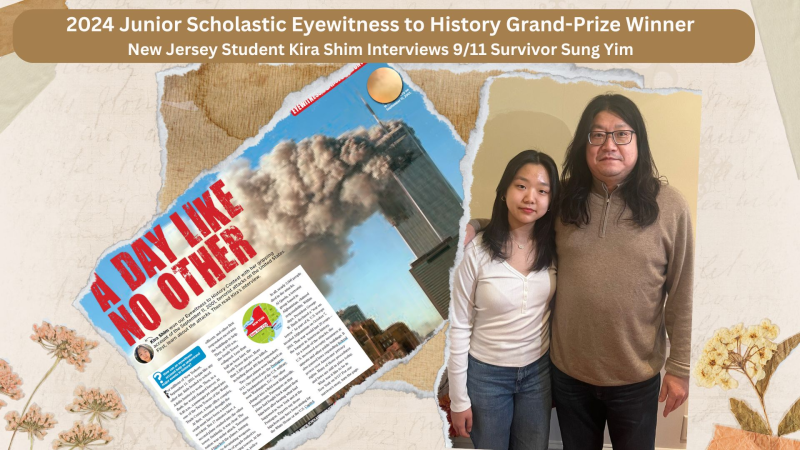It's National Poetry Month and we want to introduce you to the some very talented teen writers this month.
This year's 2017 Scholastic Art & Writing Awards recognized 16 high school seniors who received the program’s highest national honor, the Gold Medal Portfolio, which includes a $10,000 scholarship.
Throughout April, we will showcase a poem from this year's writing portfolio winners. This week, we are celebrating the work of Chasity Hale, age 18 (Miami, FL) and Seth Gozar, age 18 (Jacksonsville, FL).


What inspires you to write?
Chasity: My writing is mostly inspired by my experiences. I write to better understand the world and myself. Every piece I create is interconnected and although they can each stand alone, I like to look at them as an assemblage of works weaved together for the purposes of telling my story.
Seth: Knowing that I have an outlet for the emotions I suppress drives me to write. Honestly, if it weren’t for the assurance that I have fellow writers who understand what I feel, I wouldn’t write as often as I do.
What do you enjoy most about writing poetry?
Chasity: I think what I most enjoy about poetry is the simplicity of the craft. The actual process of creating a poem isn't simple. Poems are often deep and layered, but like postcards they are kind of like a short and quick means of communication. Garrison Keillor once said, "A postcard takes about fifty words gracefully, which is how to write one. A few sweet strokes in a flowing hand..." And poetry, for me, is kind of the same way. A poem is condensing an entire moment, a feeling, a concept into a few lines and stanzas and still having it be equally impactful, if not more so, than prose.
Seth: I love that poetry lets me explore my fears and hopes head-on. Since plot and character aren’t a necessity, I have no excuse to hide from my feelings.
Is there a poet, a writer or another creative individual whose work has inspired the way you think about art and writing?
Chasity: Yes, four of my biggest influences are Stephen Chyboski, Sarah Dessen, Terrance Hayes and Tracy K. Smith. All of these writers have inspired me to experiment with form. From Chyboski's unique epistolary novel The Perks of Being a Wallflower to Hayes' founding of poetic forms like The Golden Shovel, these writers have challenged me to think more deeply about how I structure my content. I've realized that the form writing is contained in has the ability to influence both how the material turns out and how it's interpreted. What I mean by that is, by breaking outside of my comfort zone and trying to write to different forms like writing a braided essay or a sestina, for example, I've created some of my favorite pieces and explored vastly different subject matter in the process.
Seth: I see art and writing as a way to really know one’s self, but I didn’t come to that realization until I read a poem my friend and fellow writer, Gabriella Christenson. “The Church On Moss Hill Road, Vernon, FL.” showed me that personal truth was pivotal in creating lasting impact.
What advice do you have for new poets and writers or people who want to start writing?
Chasity: I guess I would advise just new poets and writers to keep a journal. For me personally, keeping a journal is important because I like the pen first drafts on paper before I type them out. Also, I take my journal with me everywhere: on car rides, to the movies, literally everywhere, just in case I get an idea or really need to write something down. Also, for any writer, regardless of how many years they have under their belt, I think it's important to read and write as often as possible. Reading allows writers to learn more about their craft and practicing ensures that they are constantly creating content and experimenting with different genres of writing and different forms. It's also important for new writers to be un-afraid to share their work with their peers because the best way to improve a piece of writing is to get constructive criticism, then edit and revise accordingly.
Seth: My advice is to not hold back. Don’t be afraid to explore those dark, scary corners of suppressed thoughts and emotions. It’s something I still struggle with, but I’m able to dig deep into myself knowing the caliber of work it produces.
Why is it important to celebrate National Poetry Month?
Chasity: National poetry month is important to celebrate because it's a great way to expose others to the gravity and the healing powers of poetry. Through events like the O, Miami Poetry Festival and my own community outreach involving poetry, I've seen the ways in which it can positively impacts other people's lives. And by participating in events like Poem in Your Pocket Day or encouraging people to engage in the NaPoMo challenge, (writing one poem a day for a month), people can really experience the genuine joy and the deep levels of introspection that reading and writing poetry allows.
Seth: National Poetry Month is an important celebration to keep the art “alive.” Though I don’t agree, I hear the term “Poetry is dead.” quite too often. By introducing poetry at a young age via April’s festivities, these fears should be quenched.
On Climate Change by Chasity Hale
1. Growing Older
We used to be honeysuckle vines draped from a trellis,
dangling by our arms from monkey bars.
Then, we hadn’t known how we could grow in places
where we were never sown, nor did we understand
we could exist as both sweetness and bitter at once.
But childhood began to cool like beach sand at nightfall,
and we got too tired of blisters, too old to swing
across the rungs, so tall that our feet touched the ground.
The flowers of some twining bines are edible
while the berries are poison. Possibly someone
swallowed the best parts of us.
2. Free Wildlife Management
We used to think ourselves as animals,
grazing field and rolling desert, eating sun.
I remember pitching down grassy hills, climbing trees,
watching a blue jay in Ohio, and thinking,
“If only I could fly, we would be the same.”
In physics, extinction is the shattering of light.
So if we turn away as the wavelengths
of other species turn to flat lines,
separate ourselves in tandem,
pretend the earth isn’t changing, and hold on
like we do to near-broken phone chargers
bending the cord until it works—
useless, but good enough for now,
our humanness, our apex predatory
will shine brighter.
3. From The Forks of Trees
I used to see myself in the flowers.
They looked like egg yolks and sugar
beaten into soft peaks of autumn,
and the grass glowed deep green
beneath the gray-blue mountains
inhabiting the sky.
4. I Too Am Guilty of Forgetting
Somewhere glaciers are melting
the way I do into my mattress after a long day,
and water levels are rising like a diaphragm
that breathes in oxygen, but is incapable of exhaling.
5. If You Don’t Use It, You Lose It
We used to be active in caring about the world,
but like a bystander effect among expired children,
we do nothing, believing someone else will,
we do nothing, believing someone else will,
and we refuse to take any of the blame,
instead listing other reasons for the changing of the world.
“The cause of climate change is the wake of hurricanes
from the expanse of oceans, space particles and inevitability,
but never us,”
and it’s not that our jobs as salvagers of the world is finished,
it’s just that we fail to see anything worth saving anymore.
Our power of ecological empathy has grown weak;
we’ve reached the age of carelessness.
6. On Feeling Empty
Human impact is a cigarette boat
tearing through the stillness of the water,
and perhaps, the earth is something easy to leave
like a pier light on the fringe of a dock
flickering and dissipating gold into the dark.
The particles will be the only ones to remember us.
-----
Witness by Seth Gozar
Flip the switch,
the bulb flickers to life.
Above a dust-smothered bed
twisted wires glow molten.
As the sickly blush seeps out
from yellowed skin,
stale warmth drips
down clothes,
clings to hairs.
Light spills
across skin, fumbles
silent
and cool.
Flip the switch—
the bulb’s core is an ember,
just swirls of grimy-orange wire.






